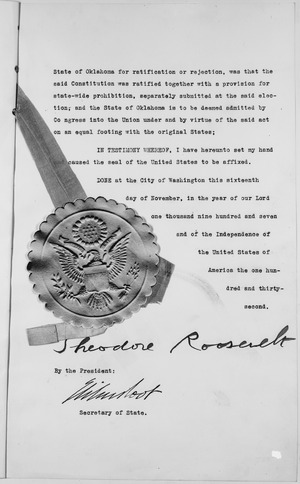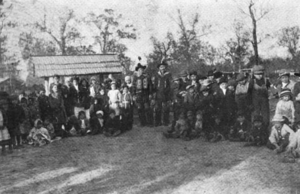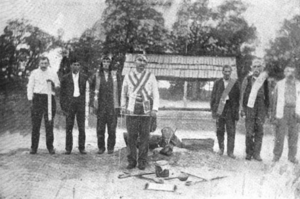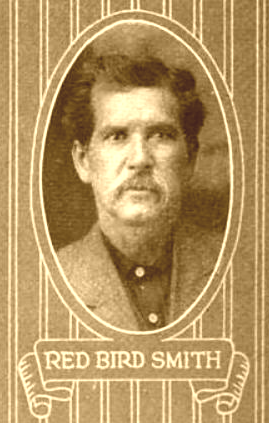Keetoowah Nighthawk Society facts for kids
The Keetoowah Nighthawk Society was a group of Cherokee people. They formed in 1858 and started again around 1900. Their main goal was to keep alive the traditional Cherokee spiritual beliefs and old ways of life. This group was based on their strong religious and cultural identity.
Redbird Smith was a key leader of the Nighthawks. He was also a member of the Cherokee National Council and the original Original Keetoowah Society. The Nighthawks formed in what was then called Indian Territory. This area later became the state of Oklahoma.
At that time, the United States government was trying to break up tribal governments. They also wanted to divide communal lands into individual plots. This was done through laws like the Dawes Act and Curtis Act. The Nighthawks stood up because some Cherokee leaders seemed to be giving up their fight. The Dawes Commission was forcing the transfer of tribal lands to individual owners. This process was called allotment.
The Keetoowah Nighthawk Society quickly grew to about 5,500 members. However, they could not stop the changes the Dawes Commission was making. In 1900, the Commission made an agreement about land allotment with Cherokee leaders. The Nighthawks were then enrolled in the tribe and registered for land. This happened even though they did not agree to it. In 1902, Redbird Smith was arrested and also forced to enroll for land.

The Nighthawks refused to accept these forced changes. As other Cherokee people became citizens of Oklahoma in 1907, the traditionalists moved away. They believed that adopting American culture was the biggest threat to their people. They went to hilly areas near Blackgum Mountain in Oklahoma.
There, they worked hard to keep their ancient Cherokee culture alive. They found a sacred wampum belt that held their history. In 1908, they chose Redbird Smith as their chief for life. But his movement began to decline. Redbird Smith, their main leader, passed away by the end of 1918.
Even so, the Keetoowah Nighthawk Society became a very important spiritual group for the Cherokee people. This happened during the early 1900s in the Indian Territory.
Contents
What Does "Keetoowah" Mean?
The word "Keetoowah" comes from the name of an ancient Cherokee town. This town, Kituwa, was in the Cherokee's original homeland in the East. It is now in North Carolina. Many Cherokee people believe that all Cherokee originated from this place.
Evidence from culture and archaeology suggests that different groups came together there. These groups migrated from the Great Lakes and Ozark Plateau regions about 3,000 years ago. There is also a belief that the ancient Keetoowah people had a special group of religious leaders. These leaders were called the Ah-ni-ku-ta-ni. They were a ruling class for thousands of years.
Cherokee legends say that when the town of Keetoowah grew too big, people moved. They created new Cherokee communities and "Mound Cities." The people from Keetoowah called themselves "the Keetoowah People." You can still see the ancient site of the Mother City of Keetoowah today. It is in Western North Carolina, near the Qualla Boundary.
Keetoowah was an ancient "Mound" city. The main earthwork mound is still visible there. Building mounds was common for many ancient cultures. This happened throughout the Mississippi Basin for thousands of years.
Some Cherokee traditionalists call themselves Ah-ni-ki-tu-wa-gi. This is also spelled Ki-tu-wa or Gi-du-wa in Oklahoma. It means "Keetoowah People." The word Ki-tu'-wa-gi means "a gathering or putting together of the Ki-tu'-wa people." This is because "gi" means "to combine" in the Cherokee Language.
Most modern Cherokee speakers do not know the original meaning of "Ki-tu-wa." It means "the mother city" or "the spiritual center" in an old dialect. The word Ki-tu'-wa-gi suggests a religious or social gathering. Honoring the mother city was like honoring Selu. Selu is the Cherokee Corn Mother. This idea is very important in Cherokee culture.
During the Green Corn Ceremony, a special dance is performed. This dance is very old and came from the mother city of Keetoowah. It is called ye-lu-le, which means "to the center." During this dance, everyone shouts ye-lu-le and moves towards the fire. The fire is in the middle of the sacred dance circle.
This dance shows how the sacred fire was given to the Keetoowah people. Their legends say it came from the Creator and the Thunder Beings. In traditional Green Corn ceremonies, Cherokee people carried coals from the central fire in Keetoowah. They used these coals to start ceremonial fires in all other Cherokee communities. Home fires were put out before the ceremonies. They were then re-lit from the coals of the Green Corn dances.
How the Society Began

The Cherokee Nation was divided by the Dawes Commission in the 1890s. The Dawes Commission wanted to force Native Americans to adopt American ways. They aimed to break up tribal governments in Oklahoma. They did this by making individual households own land.
The commission divided large areas of land into smaller plots for families. This was done to get rid of the traditional tribal governments. These governments were based on everyone owning land together. Because of the Dawes Commission, Cherokee culture and society became unstable. The federal government appointed chiefs for the tribes. These chiefs mostly carried out government plans to force the Cherokee to change.
As part of this effort, the government supported Indian boarding schools. Cherokee and other Native American children went to these schools away from their families. They were not allowed to speak their own languages. They also could not practice their own religions or cultures. Over time, much of the Cherokee culture was lost. During this period, the remaining Cherokee began to adopt practices from other tribes. These tribes were also being forced to move to Oklahoma Territory.
Redbird Smith's Leadership
To fight against this loss of culture, Redbird Smith and other Cherokee leaders formed a secret group. This was the Keetoowah Nighthawk Society. In this group, they secretly practiced traditional ceremonies and gatherings. Their goal was to save the culture, ceremonies, and beliefs of the Cherokee people. These were the ways they had before being forced to move.
Redbird Smith was a very important Nighthawk member. He helped bring back traditional spirituality among the Cherokees. He was born on July 19, 1850, near Fort Smith, Arkansas. His parents were traveling with other Cherokee people to Indian Territory from Georgia. His father, Pig Redbird Smith, strongly supported the ancient rituals and customs of eastern Indians. His mother, Lizzie Hildebrand Smith, came from a well-known Cherokee family. When Redbird was a child, his father dedicated him to serving the Cherokee people. Redbird later became chairman of the council.
In 1889, the Redbird Movement began. It separated from the original Keetoowah Society. This new group, the Keetoowah Nighthawk, was more focused on politics. They held meetings at special ceremonial areas called gatiyo (stomp grounds). Descendants of the late chief John Ross brought back Cherokee wampum belts to the Keetoowah. The Keetoowah Nighthawks strongly opposed the government's plan to divide tribal lands. Even though they fought hard, they could not stop the land allotment program.
In 1908, the Keetoowah Nighthawk Council held an election. Redbird Smith was chosen as chief. He became known as the leader of the Keetoowah Nighthawk Society. Redbird Smith was the great-grandfather of Chadwick "Corntassel" Smith, a former Cherokee Nation Principal Chief. In the early 1900s, Redbird Smith said:
I have always believed that the Great Creator had a great design for my people, the Cherokees. We must now get together as a race and render our contribution to mankind. We are endowed with intelligence, we are industrious, we are loyal, and we are spiritual. We must work. A kindly man cannot help his neighbor in need unless he have a surplus and he cannot have a surplus unless he works. Our pride in our ancestral heritage is our great incentive for handing something worth while to our posterity. It is this pride in ancestry that makes men strong and loyal for their principle in life. It is this same pride that makes men give up their all for their Government.
Redbird Smith wanted to bring back everything that was lost from the Keetoowah ways. He and some of his followers were put in jail. This was because they resisted the land allotment and the registration of tribal members. Smith passed away in 1918.
The Society Today
The Keetoowah Nighthawk Society has been brought back by the Cherokee people in Oklahoma. In Redbird Smith's time, there were more than 20 Cherokee Stomp Grounds. Today, the seven ceremonial dance grounds in Oklahoma belong to either the Keetoowah tradition or the Four Mothers Society.
The society is not a single, unified group. It is made up of different parts. These parts are not officially connected to any specific Cherokee Nation, Band, or Tribe. Members of these groups are part of many Cherokee communities in Oklahoma. Some modern groups that claim to follow the original Keetoowah culture have added Christian beliefs and new age ideas to their practices.
See also
- Cherokee removal
- Trail of Tears
- The Trail of Tears: Cherokee Legacy (film, 2006)
- Redbird Smith
- Original Keetoowah Society
- Cherokee
- Cherokee Nation



